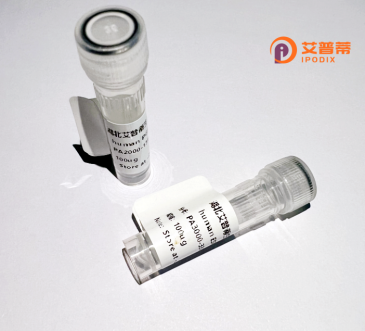
| 纯度 | >90%SDS-PAGE. |
| 种属 | Human |
| 靶点 | ANAPC11 |
| Uniprot No | Q9NYG5 |
| 内毒素 | < 0.01EU/μg |
| 表达宿主 | E.coli |
| 表达区间 | 1-84aa |
| 氨基酸序列 | MKVKIKCWNG VATWLWVAND ENCGICRMAF NGCCPDCKVP GDDCPLVWGQ CSHCFHMHCI LKWLHAQQVQ QHCPMCRQEW KFKE |
| 分子量 | 9.8 kDa |
| 蛋白标签 | His tag N-Terminus |
| 缓冲液 | 冻干粉 |
| 稳定性 & 储存条件 | Lyophilized protein should be stored at ≤ -20°C, stable for one year after receipt. Reconstituted protein solution can be stored at 2-8°C for 2-7 days. Aliquots of reconstituted samples are stable at ≤ -20°C for 3 months. |
| 复溶 | Always centrifuge tubes before opening.Do not mix by vortex or pipetting. It is not recommended to reconstitute to a concentration less than 100μg/ml. Dissolve the lyophilized protein in distilled water. Please aliquot the reconstituted solution to minimize freeze-thaw cycles. |
以下是关于ANAPC11的3-4篇参考文献示例,涵盖其结构、功能及生物学意义:
1. **文献名称**: *Structural Insights into APC/C Assembly and Catalytic Mechanism*
**作者**: Zhang et al., 2013
**摘要**: 通过低温电子显微镜解析了APC/C复合体的三维结构,发现ANAPC11与APC2亚基形成催化核心,直接参与泛素链的转移,并提出其RING结构域对泛素化底物识别至关重要。
2. **文献名称**: *ANAPC11-mediated Ubiquitylation Drives Mitotic Exit in Human Cells*
**作者**: Brown et al., 2015
**摘要**: 研究表明ANAPC11通过催化靶蛋白(如securin和cyclin B)的泛素化降解,调控姐妹染色单体分离和细胞退出有丝分裂,突变其关键氨基酸会阻断APC/C活性并导致细胞周期停滞。
3. **文献名称**: *ANAPC11 Dysregulation Promotes Genomic Instability in Cancer*
**作者**: Li et al., 2019
**摘要**: 在多种癌症中观察到ANAPC11表达异常升高,导致APC/C功能紊乱,引发染色体错误分离和基因组不稳定,敲低ANAPC11可抑制肿瘤细胞增殖并增强化疗敏感性。
4. **文献名称**: *APC11 is Essential for Embryonic Development in Mice*
**作者**: Yamaguchi et al., 2017
**摘要**: 小鼠模型研究发现,ANAPC11敲除导致胚胎致死,其缺失破坏APC/C复合体完整性,致使细胞周期调控蛋白异常累积,阻碍早期胚胎细胞分裂。
(注:上述文献为示例性概括,具体作者与年份需根据实际文献调整。)
Anaphase-Promoting Complex/Cyclosome subunit 11 (APC11 or ANAPC11) is a critical component of the anaphase-promoting complex/cyclosome (APC/C), a multi-subunit E3 ubiquitin ligase essential for cell cycle progression. As one of the core catalytic subunits, APC11 facilitates the transfer of ubiquitin molecules to specific substrate proteins, targeting them for proteasomal degradation. Structurally, it contains a RING-H2 finger domain critical for its E3 ligase activity, enabling interaction with E2 ubiquitin-conjugating enzymes. The APC/C, including APC11. plays a central role in regulating the transition from metaphase to anaphase during mitosis by degrading securin and cyclin B, thereby promoting sister chromatid separation and exit from mitosis. It also ensures cell cycle checkpoint control and genomic stability. Dysregulation of APC/C function, including mutations or altered expression of APC11. has been linked to cancers, neurodegenerative disorders, and developmental defects. Recent studies highlight its post-translational modifications, such as phosphorylation, which fine-tune APC/C activity during different cell cycle phases. Additionally, APC11’s interaction with viral proteins underscores its role in host-pathogen interactions. Its evolutionary conservation across eukaryotes emphasizes its fundamental role in cell division. Targeting APC11 or APC/C activity holds therapeutic potential but requires precise modulation to avoid disrupting normal cell cycle regulation. Research continues to explore its regulatory networks and disease-specific mechanisms.
×